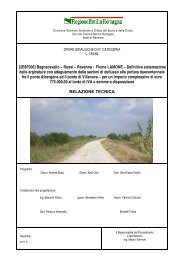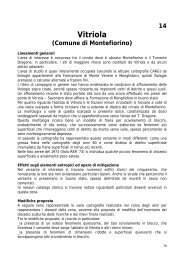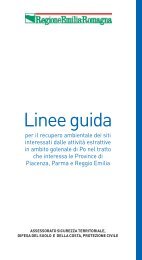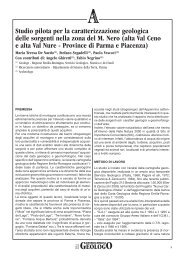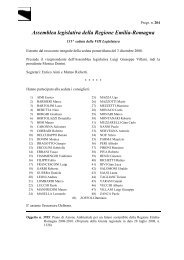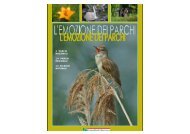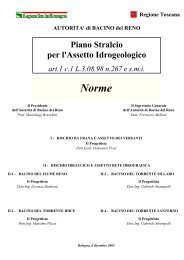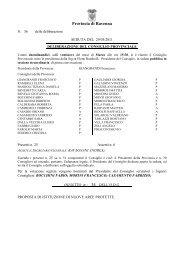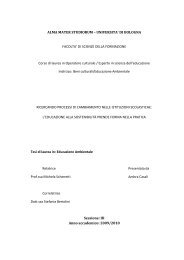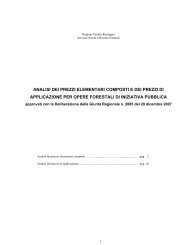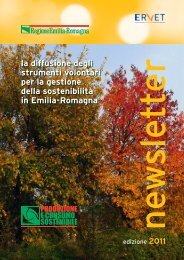air, water and soil quality qualité - ER Ambiente - Regione Emilia ...
air, water and soil quality qualité - ER Ambiente - Regione Emilia ...
air, water and soil quality qualité - ER Ambiente - Regione Emilia ...
You also want an ePaper? Increase the reach of your titles
YUMPU automatically turns print PDFs into web optimized ePapers that Google loves.
The <strong>soil</strong>s of the San Vitale Pinewood fall into the Psamments suborder. Studies<br />
carried out in the same area (Zannoni, 2008; Buscaroli <strong>and</strong> Zannoni, 2009) have<br />
highlighted how, under conditions similar to those of profiles PW3, PW7 <strong>and</strong> PW9,<br />
values of Sodium Adsorption Ratio (SAR) <strong>and</strong> of Exchangeable Sodium Percentage<br />
(ESP) observed are such so as to make <strong>soil</strong>s fall within the Sodic subgroup<br />
(SSS, 2006).<br />
Besides a strict taxonomic arrangement, the presence of soluble bases <strong>and</strong> even<br />
more their mutual relation (SAR) can substantially affect the flora development.<br />
With this respect, some authors (Álvarez-Rogel et al., 1997, 2007; Alaoui-Sossè et<br />
al., 1998) stress how, within environmental contexts similar to those under study,<br />
the variations in <strong>soil</strong>s salinity are among the main variables in the diffusion of plant<br />
species. Other authors (Gerdol et al., 1985; Piccoli et al., 1991; Blaylock, 1994;<br />
Reinman <strong>and</strong> Breckle, 1995; Álvarez-Rogel et al., 2001) associate the presence of<br />
plant species to the relation of some ionic forms <strong>and</strong> to the <strong>soil</strong> S.A.R..<br />
Profile Soil Survey Staff, 2006<br />
PW1 TYPIC PSAMMAQUENTS, mixed, calcareous, mesic<br />
PW2 TYPIC USTIPSAMMENTS Mixed, calcareous, mesic<br />
PW3 SODIC PSAMMAQUENTS Mixed, calcareous, mesic<br />
PW4 AQUIC USTIPSAMMENTS Mixed, calcareous, mesic<br />
PW5 TYPIC PSAMMAQUENTS Mixed, calcareous, mesic<br />
PW6 AQUIC USTIPSAMMENTS Mixed, calcareous, mesic<br />
PW7 SODIC PSAMMAQUENTS Mixed, calcareous, mesic<br />
PW8 TYPIC USTIPSAMMENTS Mixed, calcareous, mesic<br />
PW9 SODIC PSAMMAQUENTS Mixed, calcareous, mesic<br />
GP1 UDIFLUVENTIC HAPLUSTEPTS Fine-silty, mixed, mesic<br />
GP2 UDIFLUVENTIC HAPLUSTEPTS Coarse-loamy, mixed, mesic<br />
P<strong>ER</strong>1 UDIFLUVENTIC HAPLUSTEPTS Fine-loamy, mixed, superactive<br />
P<strong>ER</strong>2 UDIFLUVENTIC HAPLUSTEPTS Fine-silty, mixed, superactive<br />
Conclusions<br />
125<br />
Table 3 –<br />
Classification<br />
of <strong>soil</strong> profiles<br />
(SSS, 2006)<br />
Chemical-physical pedologic surveys carried out on 13 <strong>soil</strong>s profiles have made it<br />
possible to confirm the taxonomic definitions indicated in the pedologic delineations<br />
of the <strong>Emilia</strong>-Romagna region <strong>soil</strong> map (R<strong>ER</strong>, 2009). The survey carried out<br />
in the San Vitale Pinewood, along two transepts located at right angles with the<br />
dune system, has highlighted such a close relation between microtopography, surface<br />
stratum depth <strong>and</strong> relevant saline concentration as to enable a taxonomic<br />
selection at subgroup level, within the Ustipsamments/Psammaquents complex<br />
(Fig. 2).<br />
In the specific instance, profiles PW2, PW4, PW6 <strong>and</strong> PW8 located in the highest<br />
spots of the dune structure suffer either moderately (Aquic Ustipsamments, PW4<br />
<strong>and</strong> PW6) or not at all (Typic Ustipsamments, PW2 <strong>and</strong> PW8) the presence of the<br />
<strong>water</strong>-table.



